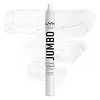What's inside
What's inside
 Key Ingredients
Key Ingredients

 Benefits
Benefits

No benefits
 Concerns
Concerns

 Ingredients Side-by-side
Ingredients Side-by-side

Isodecyl Neopentanoate
EmollientPropylene Glycol Dicaprylate/Dicaprate
EmollientSynthetic Wax
AbrasiveIsononyl Isononanoate
EmollientOctyldodecanol
EmollientParaffin
PerfumingCaprylic/Capric Triglyceride
MaskingSilica
AbrasiveDimethicone
EmollientPolyglyceryl-3 Diisostearate
EmulsifyingCera Microcristallina
Emulsion StabilisingLimnanthes Alba Seed Oil
Skin ConditioningStearalkonium Hectorite
Gel FormingDimethicone/Vinyl Dimethicone Crosspolymer
Skin ConditioningLecithin
EmollientAluminum Hydroxide
EmollientIsopropyl Myristate
EmollientPropylene Carbonate
SolventIsostearic Acid
CleansingEthylhexyl Palmitate
EmollientPolyglyceryl-3 Polyricinoleate
EmulsifyingPolyhydroxystearic Acid
EmulsifyingPhenoxyethanol
PreservativeIsodecyl Neopentanoate, Propylene Glycol Dicaprylate/Dicaprate, Synthetic Wax, Isononyl Isononanoate, Octyldodecanol, Paraffin, Caprylic/Capric Triglyceride, Silica, Dimethicone, Polyglyceryl-3 Diisostearate, Cera Microcristallina, Limnanthes Alba Seed Oil, Stearalkonium Hectorite, Dimethicone/Vinyl Dimethicone Crosspolymer, Lecithin, Aluminum Hydroxide, Isopropyl Myristate, Propylene Carbonate, Isostearic Acid, Ethylhexyl Palmitate, Polyglyceryl-3 Polyricinoleate, Polyhydroxystearic Acid, Phenoxyethanol
Isononyl Isononanoate
EmollientOctyldodecanol
EmollientEthylhexyl Palmitate
EmollientIsostearyl Isostearate
EmollientEuphorbia Cerifera Wax
Ceresin
Emulsion StabilisingMicrocrystalline Wax
Emulsion StabilisingCopernicia Cerifera Wax
Polyethylene
AbrasiveBeeswax
Emulsion StabilisingTocopheryl Acetate
AntioxidantBHA
AntioxidantButylparaben
MaskingIsobutylparaben
AntimicrobialIsopropylparaben
PreservativeMica
Cosmetic ColorantCI 77891
Cosmetic ColorantIron Oxides
CI 75470
Cosmetic ColorantCI 77288
Cosmetic ColorantCI 77007
Cosmetic ColorantCI 77510
Cosmetic ColorantCI 42090
Cosmetic ColorantCI 19140
Cosmetic ColorantIsononyl Isononanoate, Octyldodecanol, Ethylhexyl Palmitate, Isostearyl Isostearate, Euphorbia Cerifera Wax, Ceresin, Microcrystalline Wax, Copernicia Cerifera Wax, Polyethylene, Beeswax, Tocopheryl Acetate, BHA, Butylparaben, Isobutylparaben, Isopropylparaben, Mica, CI 77891, Iron Oxides, CI 75470, CI 77288, CI 77007, CI 77510, CI 42090, CI 19140
 Reviews
Reviews

Ingredients Explained
These ingredients are found in both products.
Ingredients higher up in an ingredient list are typically present in a larger amount.
Ethylhexyl Palmitate, also known as octyl palmitate, is created from 2-ethylhexyl alcohol and palmitic acid. It is a fatty acid ester.
The fatty acid content of Ethylhexyl Palmitate makes it an emollient. Emollients help soften and hydrate your skin by trapping moisture within.
Ethylhexyl Palmitate is also used to help improve the texture of cosmetics. It helps other ingredient dissolve in products and help disperse ingredients more evenly.
You'll likely find this ingredient in sunscreen, as it is often used to mix UV-blocking ingredients such as avobenzone and ethylhexyl triazone.
It can also help stabilize the fragrances in a product as a fragrance fixative.
Ethylhexyl Palmitate can be used to substitute mineral oil.
Due to its high fatty acid content, it may not be fungal-acne safe.
Learn more about Ethylhexyl PalmitateIsononyl Isononanoate is a synthetic skin-conditioner and texture enhancer. It is created from nonanoic acid, a fatty acid found in cocoa and lavender oil.
As an emollient, Isononyl Isononanoate helps keep your skin soft and smooth. This is because emollients create a barrier on the skin to trap moisture in.
Isononyl Isononanoate helps give products a velvet feel and improves spreadability.
Learn more about Isononyl IsononanoateOctyldodecanol is a fatty alcohol. It is primarily used to enhance the texture of products.
As an emulsifier, Octyldodecanol helps prevent the oils and waters from separating. It also prevents ingredients from creating foam when shaken.
Octyldodecanol is created by reducing fatty acid to an alcohol.
Due to its high molecular weight, it does not get absorbed into the skin.
Learn more about Octyldodecanol